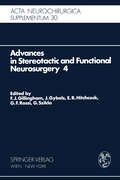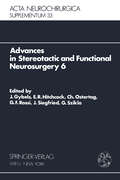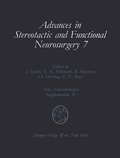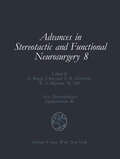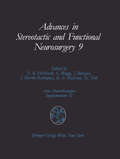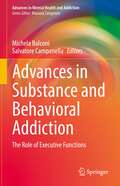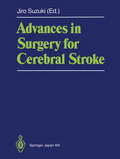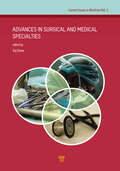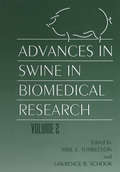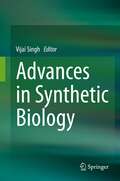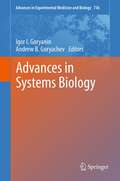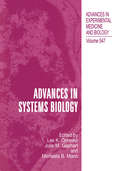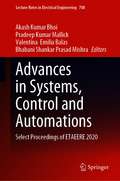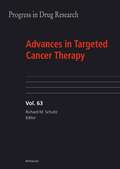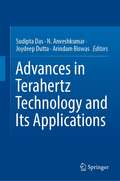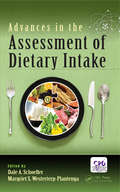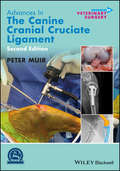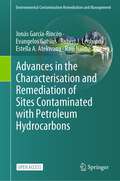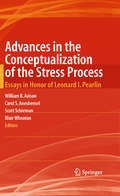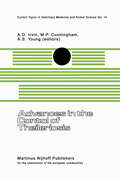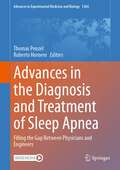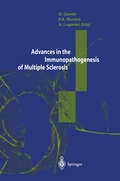- Table View
- List View
Advances in Stereotactic and Functional Neurosurgery 4: Proceedings of the 4th Meeting of the European Society for Stereotactic and Functional Neurosurgery, Paris 1979 (Acta Neurochirurgica Supplement #30)
by F. John Gillingham, Jan Gybels, Edward Hitchcock, Gian Franco Rossi and Gábor SziklaAdvances in Stereotactic and Functional Neurosurgery 6: Proceedings of the 6th Meeting of the European Society for Stereotactic and Functional Neurosurgery, Rome 1983 (Acta Neurochirurgica Supplement #33)
by J. Gybels E. R. Hitchcock C. Ostertag G. F. Rossi J. Siegfried G. SziklaLocal interstitial radiation therapy of intrinsic and inaccessible brain tumors is confronted with two major problems: 1. The tolerance of normal brain tissue, which is usually involved in local tumor irradiation, i.e. perifocal white matter edema and demyelinating effects, is crucial. 2. Data on radiation effects of implanted radioactive sources on neoplastic tissue, i.e. data on the radiosensitivity and on the biology of tumors, are still widely unavailable. In clinical practice the dose with which to achieve a given volume of tumor necrosis is roughly estimated. This report deals with the experimental findings of Iodine-125 and Iridium-I92 permanent implants in healthy and neoplastic brain tissue. Our own experimental findings are correlated with experimental data on Yttnul11-l)O irradiation from the literature. The study is directed to collect data on the tolerance non-tumoral brain tissue and to attempt to establish a dose-response relationship. Morphologic Changes in the Dog Brain Following Interstitial Iodine-125 Irradiation Iodine-I25 seeds (manufactured by 3 M Company, St. Paul, M. N.) with an activity of 3.55 mCi were permanently implanted under stereotactic conditions into the subcortical white matter of the gyrus coronalis of the left hemisphere in 6 beagle dogs. One animal with a non-radioactive seed implanted under similar operative conditions served as a control. The animals were allowed to survive 25, 46, 71, 94, 248, 368 days, respectively, after the implantation. The control animal survived 46 days. A detailed description of the experimental procedure is given elsewhere 16. 17.
Advances in Stereotactic and Functional Neurosurgery 7: Proceedings of the 7th Meeting of the European Society for Stereotactic and Functional Neurosurgery, Birmingham 1986 (Acta Neurochirurgica Supplement #39)
by J. Gybels, E. R. Hitchcock, B. Mryerson, Ch. Ostertag, G. F. RossiAdvances in Stereotactic and Functional Neurosurgery 8: Proceedings of the 8th Meeting of the European Society for Stereotactic and Functional Neurosurgery, Budapest 1988 (Acta Neurochirurgica Supplement #46)
by SzabolcsTóth Björn A. Meyerson Edward R. Hitchcock JuanBurzaco GiovanniBroggiThe last ten years has witnessed a resurgence of interest in stereotactic surgery although this has been mainly in the field of the comparatively simple stereotactic biopsy of intracranial tumours. There is also evidence of a returning interest in functional neurosurgery other than pain which has always sustained high levels of endeavour. The present work comprises selected papers from a much larger group of interesting and important communications to the European Society for Stereotactic and Functional Neurosurgery. They represent modern views on a wide variety of stereotactic surgical topics from internationally acclaimed experts in this field. The neurosurgeon who has little or no acquaintance with this fruitful sub-specialty will be surprised to find very broad applications of the technique which is gradually replacing many con ventional neurosurgical procedures. This is particularly evident in the papers on tumours but there is also a section on the treatment of vascular disease which marks an extension of neurosurgical practice. The Society has always regarded technical advances as important and some of the most recent devel opments appear in this book. Finally, an exciting new development of neural transplantation marks the beginning of what may be an important part of neurological surgery in the future.
Advances in Stereotactic and Functional Neurosurgery 9: Proceedings of the 9th Meeting of the European Society for Stereotactic and Functional Neurosurgery, Malaga 1990 (Acta Neurochirurgica Supplement #52)
by Szabolcs Tóth Björn A. Meyerson J. Martin-Rodriguez Juan Burzaco Giovanni Broggi Edward R. HitchcockThe book gives the most up-to-date information for the expanding field of stereotactic and functional neurosurgery from European and international experts. The newest developments in neural transplantation and stereotactic irradiation are included together with the reports on extensive trials of analgesic surgery and new techniques used in the treatment of a variety of functional disorders.
Advances in Substance and Behavioral Addiction: The Role of Executive Functions (Advances in Mental Health and Addiction)
by Michela Balconi Salvatore CampanellaThis book deals with recent perspectives on the panel of addiction behavior in a vast amount of population (young and adult). Thanks to the contribution of experts of the topic of addiction the volume will furnish new perspectives to formulate assessment, diagnosis and intervention in response to the increasing variety of addictions. It focuses the assessment of executive functions in substance and behavioral addictions. More specifically, this assessment consists of a new approach not only inherent to the diagnosis, but also to the treatment and prevention of addictions. In fact, there is a strict relationship between executive functions (EF) and addictive behavior: EF plays a remarkable role in significant phenomena for the treatment of addictions, such as craving, relapse and compliance to treatment.
Advances in Surgery for Cerebral Stroke: Proceedings of the International Symposium on Surgery for Cerebral Stroke, Sendai 1987
by Jiro SuzukiCerebral stroke is a common and widespread phenomenon affecting a large number of the human population worldwide. Various surgical methods have been developed for its treatment and the therapeutic results have steadily improved. This is a reassuring trend that promises further progress will be made in the future. This volume contains important contributions by leading clinicians and researchers in the field to the "International Symposium on Surgery for Cerebral Stroke" held in Sendai, Japan, May 24 - 27, 1987.
Advances in Surgical and Medical Specialties
by Raj BawaThe pace and sophistication of advances in medicine in the past two decades have been truly breathtaking. This has necessitated a growing need for comprehensive references that highlight the current issues in specific sectors of medicine. Keeping this in mind, each volume in the Current Issues in Medicine series is a stand‐alone text that provides a broad survey of various critical topics in a focused area of medicine—all accomplished in a user-friendly yet interconnected format. However, unlike other series on medicine or medical texts, this series focuses on current trends, perspectives, and issues in medicine that are central to healthcare delivery in the 21st century. Medical practitioners today continue to improve upon techniques and technologies to provide procedures for patients that are safer, faster, less invasive, and more accurate —a direct consequence of advances in technological breakthroughs from a variety of medical and engineering fields. In order to render modern patient care, it is imperative that surgeons and medical practitioners stay current with these latest advances in their respective specialties. Given this backdrop, the specific topics covered in this volume and the expertise of the contributing authors accurately reflect the rapidly evolving areas within surgical and medical specialties. While recognising how expansive and multifaceted medicine is, Advances in Surgical and Medical Specialties addresses crucial recent advances in surgical and medical specialties, intergrating the knowledge and experience of experts from academia and practicing surgeons. The multidisciplinary approach reflected here makes this volume a valuable reference resource for medical practictioners, medical students, nurses, fellows, residents, undergraduate and graduate students, educators, venture capitalists, policymakers, and biomedical researchers. A wide audience will benefit from having this volume on their bookshelf: health care systems, the pharmaceutical industry, academia, and government.
Advances in Surgical and Medical Specialties
The pace and sophistication of advances in medicine in the past two decades have been truly breathtaking. This has necessitated a growing need for comprehensive references that highlight the current issues in specific sectors of medicine. Keeping this in mind, each volume in the Current Issues in Medicine series is a stand‐alone text that provides a broad survey of various critical topics in a focused area of medicine—all accomplished in a user-friendly yet interconnected format. However, unlike other series on medicine or medical texts, this series focuses on current trends, perspectives, and issues in medicine that are central to healthcare delivery in the 21st century. Medical practitioners today continue to improve upon techniques and technologies to provide procedures for patients that are safer, faster, less invasive, and more accurate —a direct consequence of advances in technological breakthroughs from a variety of medical and engineering fields. In order to render modern patient care, it is imperative that surgeons and medical practitioners stay current with these latest advances in their respective specialties. Given this backdrop, the specific topics covered in this volume and the expertise of the contributing authors accurately reflect the rapidly evolving areas within surgical and medical specialties. While recognising how expansive and multifaceted medicine is, Advances in Surgical and Medical Specialties addresses crucial recent advances in surgical and medical specialties, intergrating the knowledge and experience of experts from academia and practicing surgeons. The multidisciplinary approach reflected here makes this volume a valuable reference resource for medical practictioners, medical students, nurses, fellows, residents, undergraduate and graduate students, educators, venture capitalists, policymakers, and biomedical researchers. A wide audience will benefit from having this volume on their bookshelf: health care systems, the pharmaceutical industry, academia, and government.
Advances in Swine in Biomedical Research: Volume 2
by Lawrence B. Schook and Mike E. TumblesonSimilarities in structure and function between pigs and human beings include size, feeding patterns, digestive physiology, dietary habits, kidney structure and function, pulmo nary vascular bed structure, coronary artery distribution, propensity to obesity, respiratory rates, tidal volumes and social behaviors. Since the pig is an omnivore, it provides an adaptable model to evaluate chronic and acute exposures to xenobiotics such as alcohoL caffeine, tobacco, food additives and environmental pollutants. Swine have been used successfully as models to evaluate alcoholism, diabetes, absorption, digestion, total paren teral nutrition, organ transplantation, atherosclerosis, exercise, hypertension. hemorrhagic hypotension, melanoma, gingivitis, obstructive and reflux nephropathy. osteochondrosis. dermal healing and septic shock. A severe and worsening shortage of organs and tissues for transplantation in patients with severe organ failure has encouraged the consideration of inter species or xenotransplan tation. In developing programs toward this end, the pig generally is viewed as the preferred donor because of its size, physiology and availability. The pig harbors relatively few diseases which could be transmitted inadvertently to human patients. The ability to genetically modify swine to ameliorate the consequences of the human immune response offers a further significant advantage. Another important consideration for an animal model is that basic biologic back ground information be available for investigators to design future prospective studies.
Advances in Synthetic Biology
by Vijai SinghThis book addresses the design of emerging conceptual tools, technologies and systems including novel synthetic parts, devices, circuits, oscillators, biological gates, and small regulatory RNAs (riboregulators and riboswitches), which serve as versatile control elements for regulating gene expression. Synthetic biology, a rapidly growing field that involves the application of engineering principles in biology, is now being used to develop novel systems for a wide range of applications including diagnostics, cell reprogramming, therapeutics, enzymes, vaccines, biomaterials, biofuels, fine chemicals and many more. The book subsequently summarizes recent developments in technologies for assembling synthetic genomes, minimal genomes, synthetic biology toolboxes, CRISPR-Cas systems, cell-free protein synthesis systems and microfluidics. Accordingly, it offers a valuable resource not only for beginners in synthetic biology, but also for researchers, students, scientists, clinicians, stakeholders and policymakers interested in the potential held by synthetic biology.
Advances in Systems Biology (Advances in Experimental Medicine and Biology #736)
by Igor I. Goryanin and Andrew B. GoryachevThe International Society for Systems Biology (ISSB) is a society aimed at advancing world-wide systems biology research by providing a forum for scientific discussions and various academic services. The ISSB helps coordinate researchers to form alliances for meeting the unique needs of multidisciplinary and international systems biology research. The annual International Conference on Systems Biology (ICSB) serves as the main meeting for the society and is one of the largest academic and commercial gatherings under the broad heading of ‘Systems Biology’.
Advances in Systems Biology (Advances in Experimental Medicine and Biology #547)
by Lee K. Opresko Julie M. Gephart Michaela B. MannAdvances in Systems, Control and Automations: Select Proceedings of ETAEERE 2020 (Lecture Notes in Electrical Engineering #708)
by Akash Kumar Bhoi Pradeep Kumar Mallick Valentina Emilia Balas Bhabani Shankar Prasad MishraThis book comprises select proceedings of the international conference ETAEERE 2020. This volume covers latest research in advanced approaches in automation, control based devices, and adaptive learning mechanisms. The contents discuss the complex operations and behaviors of different systems or machines in different environments. Some of the areas covered include control of linear and nonlinear systems, intelligent systems, stochastic control, knowledge-based systems applications, fault diagnosis and tolerant control, and real-time control applications. The contents of this volume can be useful for researchers as well as professionals working in control and automation.
Advances in Terahertz Technology and Its Applications
by Sudipta Das N. Anveshkumar Joydeep Dutta Arindam BiswasThis book highlights the growing applications of THz technology and various modules used for their successful realization. The enormous advantages of THz devices like higher resolution, spatial directivity, high-speed communication, greater bandwidth, non-ionizing signal nature and compactness make them useful in various applications like communication, sensing, security, safety, spectroscopy, manufacturing, bio-medical, agriculture, imaging, etc. Since the THz radiation covers frequencies from 0.1THz to around 10THz and highly attenuated by atmospheric gases, they are used in short-distance applications only. The book focuses on recent advances and different research issues in terahertz technology and presents theoretical, methodological, well-established and validated empirical works dealing with the different topics.
Advances in the Assessment of Dietary Intake.
by Dale A. Schoeller M. WesterterpDiet is a major factor in health and disease. Controlled, long-term studies in humans are impractical, and investigators have utilized long-term epidemiological investigations to study the contributions of diet to the human condition. Such studies, while valuable, have often been limited by contradictory findings; a limitation secondary to systematic errors in traditional self-reported dietary assessment tools that limit the percentage of variances in diseases explained by diet. New approaches are available to help overcome these limitations, and Advances in the Assessment of Dietary Intake is focused on these advances in an effort to provide more accurate dietary data to understand human health. Chapters cover the benefits and limitations of traditional self-report tools; strategies for improving the validity of dietary recall and food recording methods; objective methods to assess food and nutrient intake; assessment of timing and meal patterns using glucose sensors; and physical activity patterns using validated accelerometers. Advances in the Assessment of Dietary Intake describes new avenues to investigate the role of diet in human health and serves as the most up-to-date reference and teaching tool for these methods that will improve the accuracy of dietary assessment and lay the ground work for future studies.
Advances in the Assessment of Dietary Intake.
by Dale A. Schoeller M. WesterterpDiet is a major factor in health and disease. Controlled, long-term studies in humans are impractical, and investigators have utilized long-term epidemiological investigations to study the contributions of diet to the human condition. Such studies, while valuable, have often been limited by contradictory findings; a limitation secondary to systematic errors in traditional self-reported dietary assessment tools that limit the percentage of variances in diseases explained by diet. New approaches are available to help overcome these limitations, and Advances in the Assessment of Dietary Intake is focused on these advances in an effort to provide more accurate dietary data to understand human health. Chapters cover the benefits and limitations of traditional self-report tools; strategies for improving the validity of dietary recall and food recording methods; objective methods to assess food and nutrient intake; assessment of timing and meal patterns using glucose sensors; and physical activity patterns using validated accelerometers. Advances in the Assessment of Dietary Intake describes new avenues to investigate the role of diet in human health and serves as the most up-to-date reference and teaching tool for these methods that will improve the accuracy of dietary assessment and lay the ground work for future studies.
Advances in the Canine Cranial Cruciate Ligament (AVS Advances in Veterinary Surgery)
by Peter MuirAdvances in the Canine Cranial Cruciate Ligament, Second Edition presents in-depth, focused, and updated coverage of current knowledge on cruciate ligament rupture, using a multidisciplinary, evidence-based approach. Presents a state-of-the-art summary of the most recent knowledge on this important cause of lameness in dogs Led by a highly respected surgeon and researcher, with chapters written by leading experts in the field Provides an update to the groundbreaking first edition, with six new chapters
Advances in the Canine Cranial Cruciate Ligament (AVS Advances in Veterinary Surgery)
by Peter MuirAdvances in the Canine Cranial Cruciate Ligament, Second Edition presents in-depth, focused, and updated coverage of current knowledge on cruciate ligament rupture, using a multidisciplinary, evidence-based approach. Presents a state-of-the-art summary of the most recent knowledge on this important cause of lameness in dogs Led by a highly respected surgeon and researcher, with chapters written by leading experts in the field Provides an update to the groundbreaking first edition, with six new chapters
Advances in the Characterisation and Remediation of Sites Contaminated with Petroleum Hydrocarbons (Environmental Contamination Remediation and Management)
by Jonás García-Rincón Evangelos Gatsios Robert J. Lenhard Estella A. Atekwana Ravi NaiduThis open access book synthesizes important advances in the assessment and management of soil and groundwater systems contaminated with petroleum hydrocarbons, especially in the form of light non-aqueous phase liquids (LNAPLs). LNAPL characterization and remediation is challenging due to the multi-phase, multi-component nature of the problem and the various physical, chemical, and biological processes involved in a dynamic and heterogeneous hydrogeological setting. This book focuses on the current state of practice of LNAPL characterization and remediation and seeks to provide information and a framework that would allow some of these complexities to be better addressed by contaminated land practitioners, researchers, and regulators.
Advances in the Conceptualization of the Stress Process: Essays in Honor of Leonard I. Pearlin
by William R. Avison Carol S. Aneshensel Scott Schieman Blair WheatonIn 1981, Leonard Pearlin and his colleagues published an article that would ra- cally shift the sociological study of mental health from an emphasis on psychiatric disorder to a focus on social structure and its consequences for stress and psyc- logical distress. Pearlin et al. (1981) proposed a deceptively simple conceptual model that has now influenced sociological inquiry for almost three decades. With his characteristic penchant for reconsidering and elaborating his own ideas, Pearlin has revisited the stress process model periodically over the years (Pearlin 1989, 1999; Pearlin et al. 2005; Pearlin and Skaff 1996). One of the consequences of this continued theoretical elaboration of the stress process has been the development of a sociological model of stress that embraces the complexity of social life. Another consequence is that the stress process has continued to stimulate a host of empirical investigations in the sociology of mental health. Indeed, it is no exaggeration to suggest that the stress process paradigm has been primarily responsible for the growth and sustenance of sociological research on stress and mental health. Pearlin et al. (1981) described the core elements of the stress process in a brief paragraph: The process of social stress can be seen as combining three major conceptual domains: the sources of stress, the mediators of stress, and the manifestations of stress. Each of these extended domains subsumes a variety of subparts that have been intensively studied in recent years.
Advances in the Control of Theileriosis: Proceedings of an International Conference held at the International Laboratory for Research on Animal Diseases in Nairobi, 9–13th February, 1981 (Current Topics in Veterinary Medicine #14)
by A. D. Irvin M. P. Cunningham A. S. YoungApproximately five years have elapsed since the Conference on "Tick-borne Diseases and their Vectors" (Wilde, 1978, University of Edinburgh) was held at the Centre for Tropical Veterinary Medicine in Edinburgh. Theileriosis was one of the main topics at that Conference and some 20 scientific presentations were given. Also in the same year a Workshop on "Theileriosis" was held at the Kenyatta Conference Centre in Nairobi (Henson & Campbell, 1977, IDRC, Ottawa). Both of these meetings provided a valuable up dating of theilerial diseases, and the Proceedings have been a constant source of reference for scientists in the ensuing years. The meetings played a significant role in setting the scene for a number of important advances which have been made since then. In February of this year, attention was focused on these advances when nearly 200 scientists from over 30 countries were assembled at the International Laboratory for Research on Animal Diseases in Nairobi for the international conference on "Advances in the Control of Theileriosis". The interest and concern shown in this subject has now grown to the extent that more than 70 scientific presentations were given over the course of a very busy week. An important facet of the Conference was the attention given to the control of Theileriosis, since this must be the ultimate aim of all those involved with the disease. Control will be difficult.
Advances in the Diagnosis and Treatment of Sleep Apnea: Filling the Gap Between Physicians and Engineers (Advances in Experimental Medicine and Biology #1384)
by Thomas Penzel Roberto HorneroThe book focuses on biomedical innovations related to the diagnosis and treatment of sleep apnea. The latest diagnostic tools are described, including sleep laboratory equipment, wearables, and even smartphone apps. Innovative medical devices for treatment are also covered, such as CPAP, Auto-PAP, hypoglossal nerve stimulation, phrenic nerve stimulation, acoustic brain stimulation and electrical brain stimulation. This is an ideal book for biomedical engineers, pneumologists, neurologists, cardiologists, physiologists, ENT physicians, pediatrics, and epidemiologists who are interested in learning about the latest technologies in treating and diagnosing sleep apnea.
Advances in the Immunopathogenesis of Multiple Sclerosis
by U. Ecari A. Lugaresi P. A. Muraro D. GambiP.A. MURARO, A. LUGARESI, D. GAMBI Many of the pathological aspects of multiple sclerosis (MS) lesions have been known for over a century. It is only recently, however, that different patterns of demyelination have been linked to distinct pathways of immune-mediated tissue destruction. In particular, the inter-individual heterogeneity of MS lesions has suggested that different mechanisms may act in different patients, accounting for the variability observed in clinical course, immunological findings in peripheral blood and cere brospinal fluid (CSF), and response to immunomodulatory treatments. To provide an overview of the basic mechanisms possibly involved in MS lesion initiation and development, an international meeting was organized in the context of the annual Congress of the Italian Neuroimmunology Association (AINI), held at the University of Chieti, in Chieti Italy on 29 October 1998. The high standard of presentations prompted us to report them in extended form, to highlight recent pro gress in the understanding of basic mechanisms sustaining MS immuno pathogenesis. A central role in the possible mechanisms leading to myelin destruc tion has been attributed to T lymphocytes reactive to myelin antigens. Studies on the myelin antigen-specific T cell repertoire have contributed significant advances to our knowledge of autoimmunity (Chapters 1,2).
